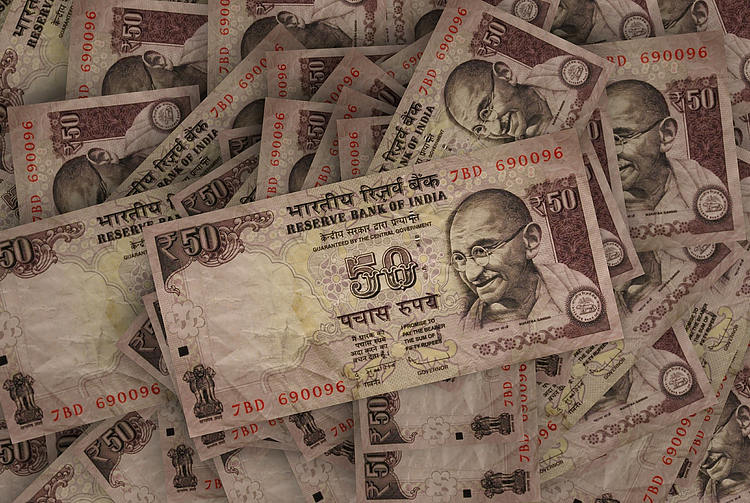- The Indian Rupee (INR) edges lower on Monday despite the softer USD.
- The RBI is likely to maintain its monetary policy stance as the upside risks to food inflation remain.
- Market players will closely watch the Indian and US CPI inflation data for February, due on Tuesday.
The Indian Rupee (INR) trades on a weaker note on Monday, despite the decline of the US dollar (USD). The mixed US February labor market data on Friday has exerted some selling pressure on the Greenback as it has triggered the possibility of a rate cut in June.
The markets estimate the Indian Consumer Price Index (CPI) inflation for February to ease to 5.02{721fc769be108e463fe4e33f629fb22fe291c423a7a69eaaf65dcb28e9b05dea} from 5.10{721fc769be108e463fe4e33f629fb22fe291c423a7a69eaaf65dcb28e9b05dea} in January. Analysts believe that the upside risks to food inflation remain, and it should keep the RBI on the sidelines for longer with no urgency to cut rates. This, in turn, might boost the Indian Rupee and act as a headwind for the USD/INR pair.
Investors will keep an eye on India’s CPI inflation and Industrial Production on Tuesday. On Wednesday, the attention will shift to the Wholesale Price Index (WPI) of Food, Fuel and Inflation. On the US docket, the February CPI and Retail Sales will be released on Tuesday and Thursday, respectively.
Daily Digest Market Movers: Indian Rupee remains sensitive to high inflation, geopolitical risks
- The INR has climbed 0.5{721fc769be108e463fe4e33f629fb22fe291c423a7a69eaaf65dcb28e9b05dea} this year, making it Asia’s top-performing currency in 2024, as foreign investors continued to purchase local bonds ahead of the country’s entry into global debt indexes.
- Traders will monitor the maturity of the Reserve Bank of India’s $5 billion USD/INR sell-buy swap on Monday, which might impact the overnight USD/INR swap rate and forward premiums.
- The US Nonfarm Payrolls rose by 275K in February from 229K in January, stronger than the market expectation of 200K, according to the US Bureau of Labor Statistics (BLS) on Friday.
- The Unemployment Rate in the US rose to 3.9{721fc769be108e463fe4e33f629fb22fe291c423a7a69eaaf65dcb28e9b05dea} in February from 3.7{721fc769be108e463fe4e33f629fb22fe291c423a7a69eaaf65dcb28e9b05dea} in January, the highest level in two years.
- The US wage growth, as measured by the Average Hourly Earnings, rose by 4.3{721fc769be108e463fe4e33f629fb22fe291c423a7a69eaaf65dcb28e9b05dea} YoY in February versus 4.4{721fc769be108e463fe4e33f629fb22fe291c423a7a69eaaf65dcb28e9b05dea} prior, below the market consensus of 4.4{721fc769be108e463fe4e33f629fb22fe291c423a7a69eaaf65dcb28e9b05dea}.
- Fed Chair Powell said last week during his semiannual testimony that more confidence is needed before the central bank is ready to lower the rate, but they’re not far from it.
Technical Analysis: Indian Rupee remains capped within a longer range of 82.60-83.15
Indian Rupee weakens on the day. USD/INR remains confined within a multi-month-old descending trend channel since December 8, 2023 around 82.60-83.15.
In the near term, the bearish outlook of USD/INR remains intact as the pair is the 100-day Exponential Moving Average (EMA) on the daily chart. Additionally, the 14-day Relative Strength Index (RSI) lies in bearish territory below the 50.0 midlines, indicating that further decline looks favorable.
The potential support level will emerge near the lower limit of the descending trend channel at 82.60. A breach of this level could draw in more bears and put a move back to a low of August 23 at 82.45 and finally a low of June 1 at 82.25.
On the bright side, the confluence of the 100-day EMA and a psychological round figure of 83.00 act as an immediate resistance level. Further north, the pair could open up a move to the upper boundary of the descending trend channel at 83.15. An upside breakout above 83.15 will see a rally to a high of January 2 at 83.35, en route to 84.00.
US Dollar price today
The table below shows the percentage change of US Dollar (USD) against listed major currencies today. US Dollar was the strongest against the Australian Dollar.
| USD | EUR | GBP | CAD | AUD | JPY | NZD | CHF | |
| USD | 0.03{721fc769be108e463fe4e33f629fb22fe291c423a7a69eaaf65dcb28e9b05dea} | 0.05{721fc769be108e463fe4e33f629fb22fe291c423a7a69eaaf65dcb28e9b05dea} | 0.01{721fc769be108e463fe4e33f629fb22fe291c423a7a69eaaf65dcb28e9b05dea} | 0.22{721fc769be108e463fe4e33f629fb22fe291c423a7a69eaaf65dcb28e9b05dea} | 0.21{721fc769be108e463fe4e33f629fb22fe291c423a7a69eaaf65dcb28e9b05dea} | 0.14{721fc769be108e463fe4e33f629fb22fe291c423a7a69eaaf65dcb28e9b05dea} | -0.01{721fc769be108e463fe4e33f629fb22fe291c423a7a69eaaf65dcb28e9b05dea} | |
| EUR | -0.03{721fc769be108e463fe4e33f629fb22fe291c423a7a69eaaf65dcb28e9b05dea} | 0.02{721fc769be108e463fe4e33f629fb22fe291c423a7a69eaaf65dcb28e9b05dea} | -0.03{721fc769be108e463fe4e33f629fb22fe291c423a7a69eaaf65dcb28e9b05dea} | 0.18{721fc769be108e463fe4e33f629fb22fe291c423a7a69eaaf65dcb28e9b05dea} | 0.19{721fc769be108e463fe4e33f629fb22fe291c423a7a69eaaf65dcb28e9b05dea} | 0.12{721fc769be108e463fe4e33f629fb22fe291c423a7a69eaaf65dcb28e9b05dea} | -0.02{721fc769be108e463fe4e33f629fb22fe291c423a7a69eaaf65dcb28e9b05dea} | |
| GBP | -0.05{721fc769be108e463fe4e33f629fb22fe291c423a7a69eaaf65dcb28e9b05dea} | -0.02{721fc769be108e463fe4e33f629fb22fe291c423a7a69eaaf65dcb28e9b05dea} | -0.05{721fc769be108e463fe4e33f629fb22fe291c423a7a69eaaf65dcb28e9b05dea} | 0.17{721fc769be108e463fe4e33f629fb22fe291c423a7a69eaaf65dcb28e9b05dea} | 0.16{721fc769be108e463fe4e33f629fb22fe291c423a7a69eaaf65dcb28e9b05dea} | 0.09{721fc769be108e463fe4e33f629fb22fe291c423a7a69eaaf65dcb28e9b05dea} | -0.05{721fc769be108e463fe4e33f629fb22fe291c423a7a69eaaf65dcb28e9b05dea} | |
| CAD | 0.00{721fc769be108e463fe4e33f629fb22fe291c423a7a69eaaf65dcb28e9b05dea} | 0.02{721fc769be108e463fe4e33f629fb22fe291c423a7a69eaaf65dcb28e9b05dea} | 0.04{721fc769be108e463fe4e33f629fb22fe291c423a7a69eaaf65dcb28e9b05dea} | 0.19{721fc769be108e463fe4e33f629fb22fe291c423a7a69eaaf65dcb28e9b05dea} | 0.19{721fc769be108e463fe4e33f629fb22fe291c423a7a69eaaf65dcb28e9b05dea} | 0.13{721fc769be108e463fe4e33f629fb22fe291c423a7a69eaaf65dcb28e9b05dea} | 0.00{721fc769be108e463fe4e33f629fb22fe291c423a7a69eaaf65dcb28e9b05dea} | |
| AUD | -0.22{721fc769be108e463fe4e33f629fb22fe291c423a7a69eaaf65dcb28e9b05dea} | -0.19{721fc769be108e463fe4e33f629fb22fe291c423a7a69eaaf65dcb28e9b05dea} | -0.17{721fc769be108e463fe4e33f629fb22fe291c423a7a69eaaf65dcb28e9b05dea} | -0.23{721fc769be108e463fe4e33f629fb22fe291c423a7a69eaaf65dcb28e9b05dea} | 0.00{721fc769be108e463fe4e33f629fb22fe291c423a7a69eaaf65dcb28e9b05dea} | -0.07{721fc769be108e463fe4e33f629fb22fe291c423a7a69eaaf65dcb28e9b05dea} | -0.21{721fc769be108e463fe4e33f629fb22fe291c423a7a69eaaf65dcb28e9b05dea} | |
| JPY | -0.19{721fc769be108e463fe4e33f629fb22fe291c423a7a69eaaf65dcb28e9b05dea} | -0.18{721fc769be108e463fe4e33f629fb22fe291c423a7a69eaaf65dcb28e9b05dea} | 0.09{721fc769be108e463fe4e33f629fb22fe291c423a7a69eaaf65dcb28e9b05dea} | -0.21{721fc769be108e463fe4e33f629fb22fe291c423a7a69eaaf65dcb28e9b05dea} | 0.02{721fc769be108e463fe4e33f629fb22fe291c423a7a69eaaf65dcb28e9b05dea} | -0.06{721fc769be108e463fe4e33f629fb22fe291c423a7a69eaaf65dcb28e9b05dea} | -0.22{721fc769be108e463fe4e33f629fb22fe291c423a7a69eaaf65dcb28e9b05dea} | |
| NZD | -0.14{721fc769be108e463fe4e33f629fb22fe291c423a7a69eaaf65dcb28e9b05dea} | -0.12{721fc769be108e463fe4e33f629fb22fe291c423a7a69eaaf65dcb28e9b05dea} | -0.10{721fc769be108e463fe4e33f629fb22fe291c423a7a69eaaf65dcb28e9b05dea} | -0.15{721fc769be108e463fe4e33f629fb22fe291c423a7a69eaaf65dcb28e9b05dea} | 0.07{721fc769be108e463fe4e33f629fb22fe291c423a7a69eaaf65dcb28e9b05dea} | 0.06{721fc769be108e463fe4e33f629fb22fe291c423a7a69eaaf65dcb28e9b05dea} | -0.15{721fc769be108e463fe4e33f629fb22fe291c423a7a69eaaf65dcb28e9b05dea} | |
| CHF | 0.00{721fc769be108e463fe4e33f629fb22fe291c423a7a69eaaf65dcb28e9b05dea} | 0.03{721fc769be108e463fe4e33f629fb22fe291c423a7a69eaaf65dcb28e9b05dea} | 0.05{721fc769be108e463fe4e33f629fb22fe291c423a7a69eaaf65dcb28e9b05dea} | -0.01{721fc769be108e463fe4e33f629fb22fe291c423a7a69eaaf65dcb28e9b05dea} | 0.19{721fc769be108e463fe4e33f629fb22fe291c423a7a69eaaf65dcb28e9b05dea} | 0.19{721fc769be108e463fe4e33f629fb22fe291c423a7a69eaaf65dcb28e9b05dea} | 0.14{721fc769be108e463fe4e33f629fb22fe291c423a7a69eaaf65dcb28e9b05dea} |
The heat map shows percentage changes of major currencies against each other. The base currency is picked from the left column, while the quote currency is picked from the top row. For example, if you pick the Euro from the left column and move along the horizontal line to the Japanese Yen, the percentage change displayed in the box will represent EUR (base)/JPY (quote).
Indian Rupee FAQs
The Indian Rupee (INR) is one of the most sensitive currencies to external factors. The price of Crude Oil (the country is highly dependent on imported Oil), the value of the US Dollar – most trade is conducted in USD – and the level of foreign investment, are all influential. Direct intervention by the Reserve Bank of India (RBI) in FX markets to keep the exchange rate stable, as well as the level of interest rates set by the RBI, are further major influencing factors on the Rupee.
The Reserve Bank of India (RBI) actively intervenes in forex markets to maintain a stable exchange rate, to help facilitate trade. In addition, the RBI tries to maintain the inflation rate at its 4{721fc769be108e463fe4e33f629fb22fe291c423a7a69eaaf65dcb28e9b05dea} target by adjusting interest rates. Higher interest rates usually strengthen the Rupee. This is due to the role of the ‘carry trade’ in which investors borrow in countries with lower interest rates so as to place their money in countries’ offering relatively higher interest rates and profit from the difference.
Macroeconomic factors that influence the value of the Rupee include inflation, interest rates, the economic growth rate (GDP), the balance of trade, and inflows from foreign investment. A higher growth rate can lead to more overseas investment, pushing up demand for the Rupee. A less negative balance of trade will eventually lead to a stronger Rupee. Higher interest rates, especially real rates (interest rates less inflation) are also positive for the Rupee. A risk-on environment can lead to greater inflows of Foreign Direct and Indirect Investment (FDI and FII), which also benefit the Rupee.
Higher inflation, particularly, if it is comparatively higher than India’s peers, is generally negative for the currency as it reflects devaluation through oversupply. Inflation also increases the cost of exports, leading to more Rupees being sold to purchase foreign imports, which is Rupee-negative. At the same time, higher inflation usually leads to the Reserve Bank of India (RBI) raising interest rates and this can be positive for the Rupee, due to increased demand from international investors. The opposite effect is true of lower inflation.



